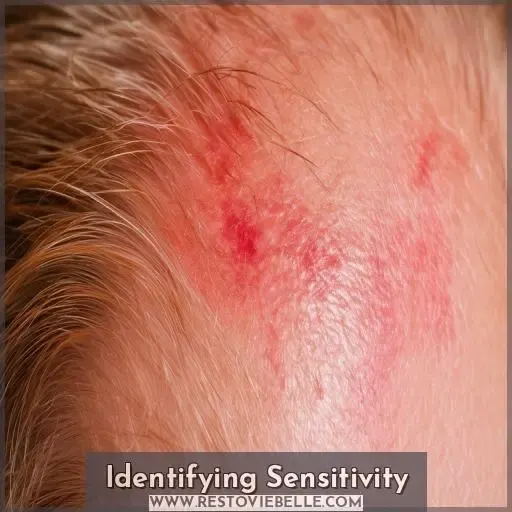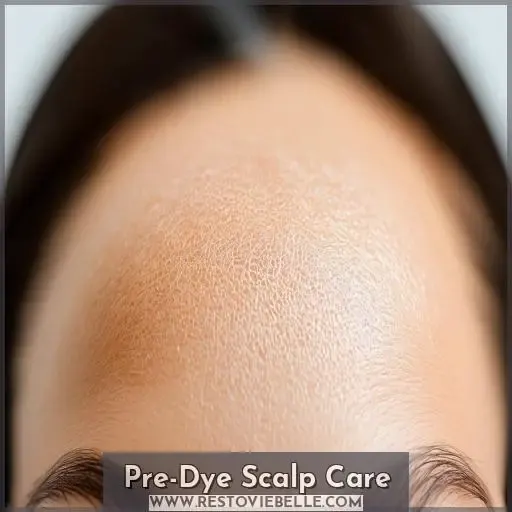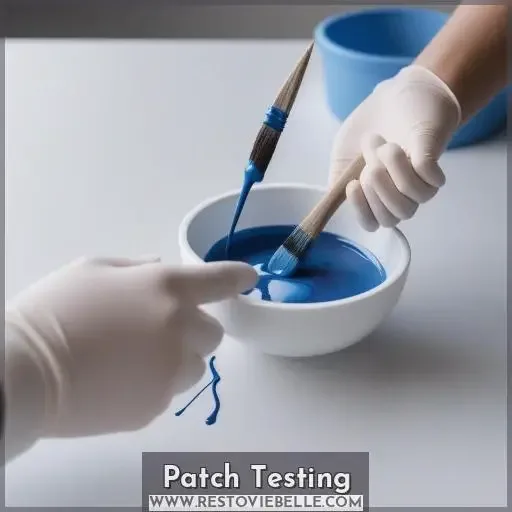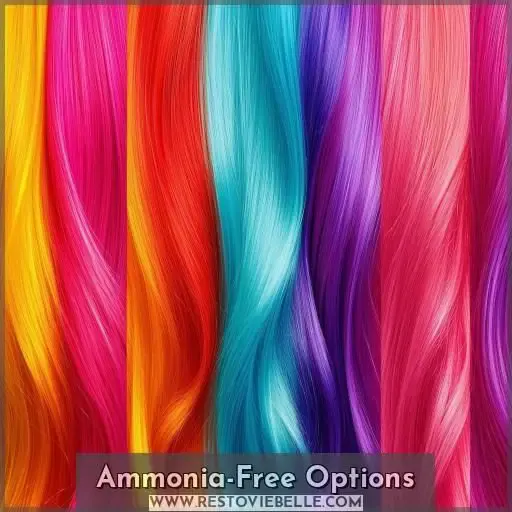This site is supported by our readers. We may earn a commission, at no cost to you, if you purchase through links.
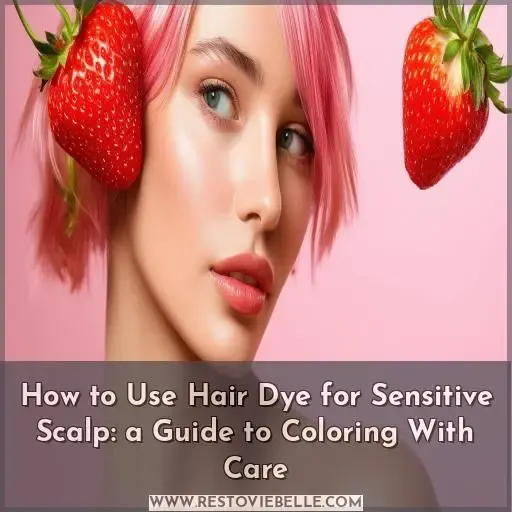 To use hair dye for sensitive scalp, start by identifying your sensitivity level through signs like tingling, redness, or irritation.
To use hair dye for sensitive scalp, start by identifying your sensitivity level through signs like tingling, redness, or irritation.
Next, gently cleanse and exfoliate your scalp before coloring.
When choosing dye, avoid harsh chemicals like ammonia and PPD by opting for gentler semi-permanent or henna options.
Always perform a patch test 48 hours prior to check for reactions.
Apply the dye carefully, then soothe post-color irritation with color-safe, hydrating products.
For ultimate scalp care, consider an ammonia-free formula or embrace the benefits of nourishing natural alternatives like henna.
Proper preparation paves the way for a safe, comfortable coloring experience.
Table Of Contents
- Key Takeaways
- How to Use Hair Dye for Sensitive Scalp?
- Identifying Sensitivity
- Pre-Dye Scalp Care
- Choosing Gentle Hair Dye
- Patch Testing
- Applying Hair Dye Safely
- Post-Dye Scalp Care
- Ammonia-Free Options
- Benefits of Natural Alternatives
- Prime Hair Scalp Protector
- Consult a Specialist
- Frequently Asked Questions (FAQs)
- How to dye hair with sensitive scalp?
- How do you keep hair dye from irritating your scalp?
- Which hair color is best for a sensitive scalp?
- What can I use to dye my hair if I’m allergic to hair dye?
- How long does a hair dye allergy take to develop?
- Can hair dye allergies cause anaphylaxis?
- What is the main allergen in hair dyes?
- How can henna protect against dandruff and psoriasis?
- Is Wella Koleston Perfect Innosense approved for allergy sufferers?
- Conclusion
Key Takeaways
- Listen to your scalp’s whispers, dear friend! If you experience tingling, redness, or irritation during coloring, your sensitive soul is trying to communicate. Embrace those cues as a gentle nudge toward a new hair hue haven.
- Treat your tresses and tender scalp like royalty by opting for gentle, natural hair dyes devoid of harsh chemicals. Ammonia and PPD? Banish them from your beauty ritual! Embrace the luscious locks of a henna goddess instead.
- Remember, a patch test is like a friendship bracelet – it symbolizes trust and care. Take the time to ensure your chosen dye plays nicely with your skin’s delicate disposition before committing to the full-color transformation.
- After the color ceremony, shower your scalp with love and nourishment. Indulge in soothing, color-safe products that caress your tresses and whisper sweet nothings to your sensitive soul. Cool showers and scalp treatments? Consider them self-care essentials!
How to Use Hair Dye for Sensitive Scalp?
When using hair dye for a sensitive scalp, start by identifying the signs of sensitivity and conducting a patch test to verify the product is safe . Then, choose a gentle, ammonia-free hair dye and follow the application instructions carefully for the best results .
Identifying Sensitivity
If your scalp tingles, turns red, or feels irritated during or after coloring your hair, you may have a sensitive scalp.
Dry, flaky skin, dandruff, and discomfort when using certain hair products are other signs.
People with sensitive skin are more prone to scalp sensitivity.
Henna, a natural hair dye alternative, is gentle on sensitive skin and has antifungal properties that protect against dandruff and psoriasis.
Avoid harsh chemicals like ammonia in commercial hair dyes.
Perform a patch test 48 hours before coloring to check for reactions.
If you experience sensitivity, switch to a gentler, natural hair dye option to keep your scalp healthy and happy.
Pre-Dye Scalp Care
Before coloring your sensitive scalp, it is imperative to prepare your hair and scalp for the process.
Start by using a gentle, sulfate-free shampoo and conditioner designed specifically for sensitive skin.
Avoid harsh styling products or heat tools, as they can further irritate your scalp.
Exfoliate your scalp gently to remove any dead skin cells.
Apply a soothing scalp treatment to hydrate and calm any irritation.
If you are prone to allergic reactions, consider taking an antihistamine before your color service to reduce the risk of itching or inflammation.
Choosing Gentle Hair Dye
When choosing a gentle hair dye for sensitive scalps, it’s essential to avoid harsh chemicals like ammonia, paraphenylenediamine (PPD), and sulfates that can cause irritation, burning, and allergic reactions. Always perform a patch test at least 48 hours before applying any new hair color, even if labeled natural, to check for potential sensitivities.
Choosing Gentle Hair Dye
Opt for demi or semi-permanent hair color to gently cover grays and avoid harsh oxidative dyes that can irritate sensitive scalps. Steer clear of ammonia and PPD-based permanent dyes.
Avoid Harsh Chemicals
Steer clear of harsh chemicals like ammonia, paraphenylenediamine, and sulfates. Opt for gentle, chemical-free solutions like:
- Natural hair dye options
- Home remedies for scalp protection
- DIY scalp treatments with calming ingredients
Perform Patch Test
Perform a patch test 48 hours before coloring to check for skin reactions or scalp irritation. Apply a small amount of hair color to your skin and wait to see if any reaction occurs (Source).
Use Henna Alternative
For a gentle, natural hair color alternative, try henna. Henna’s antifungal properties protect against dandruff and psoriasis (Source). It’s more cost-effective and environmentally friendly than chemical dyes . Henna is a great choice for sensitive scalps.
Patch Testing
Before you embark on coloring your hair, it’s imperative to conduct a patch test.
Combine a modest amount of the hair dye and apply it to an unobtrusive area of your skin, such as the inner surface of your arm or behind your ear. Leave it on for the same duration you’d keep the dye in your hair. Rinse thoroughly and wait 48 hours.
If you experience any redness, itching, or burning, discontinue use promptly. A patch test is essential to discern potential skin sensitivity or allergic reactions.
If you’ve had a recurring issue with scalp irritation, consider using a primer to create a protective barrier before applying color.
Better safe than sorry when it comes to the health of your scalp.
Applying Hair Dye Safely
Now that you’ve patch tested the hair dye and confirmed it’s safe for your sensitive skin, it’s time to apply the color.
First, use a soft-bristle brush to apply a scalp protector to your hairline and part. This creates a barrier between your skin and the dye.
When mixing the color, add a few drops of the protector to the formula.
Gently apply the dye, avoiding direct contact with your scalp. Process according to the package instructions, then rinse thoroughly.
Awareness of your hair dye ingredients and using a scalp protector are key to coloring your sensitive skin safely. Stick to gentle, ammonia-free dyes or natural henna alternatives for the best results.
Post-Dye Scalp Care
After coloring your hair, it’s essential to take care of your sensitive scalp.
Use a color-safe shampoo and conditioner to gently cleanse and hydrate your locks.
Apply a soothing scalp treatment to calm any irritation or inflammation.
Avoid scratching or picking at your scalp, as this can exacerbate the problem.
Take cool showers to reduce further irritation.
If your sensitivity persists or worsens, don’t hesitate to consult a dermatologist. They can provide professional advice and prescribe medicated treatments if necessary.
Ammonia-Free Options
When dealing with a sensitive scalp, opting for ammonia-free or low-ammonia dyes can greatly reduce the risk of irritation and allergic reactions.
Choose semi-permanent or demi-permanent color options as these are gentler on the scalp while still providing beautiful results.
Performing a patch test before full application is essential to verify compatibility with your skin.
These alternative options are less likely to trigger scalp sensitivity while coloring your hair effectively.
Benefits of Natural Alternatives
For those seeking a hypoallergenic alternative to conventional hair dyes, henna is a fantastic natural option. As a cost-effective solution that strengthens hair follicles while nourishing the scalp, henna’s gentle formulation makes it an ideal choice for individuals with sensitive skin.
Hypoallergenic properties of Henna
Henna’s antifungal properties protect your sensitive scalp from dandruff and psoriasis, while strengthening hair follicles to reduce shedding. This natural alternative is hypoallergenic, cost-effective, and eco-friendly compared to harsh chemical dyes (Source).
Cost-effective natural alternative
When considering cost-effective natural alternatives for sensitive scalps, henna stands out as a compelling choice. Its benefits include being a more affordable option compared to chemical dyes. Additionally, henna offers relief to those with scalp irritation and PPD allergies, all while providing a natural antifungal solution.
Hair follicle strengthening
Henna’s natural properties strengthen hair follicles, reducing breakage and loss while promoting healthy growth and density. Bid farewell to thinning locks and embrace the power of this gentle, nourishing alternative to harsh chemical dyes.
| Benefits of Henna | |
|---|---|
| Strengthens follicles | Reduces breakage |
| Promotes growth | Increases density |
| Nourishes hair | Natural alternative |
Prime Hair Scalp Protector
When dealing with a sensitive scalp, proper scalp preparation is essential before applying hair dye to minimize irritation and reduce the risk of skin damage. Utilizing a prime hair scalp protector can provide an effective protective barrier, safeguarding the scalp against potential irritants and allergens present in hair dye products. Here are essential steps for using a prime hair scalp protector:
- Gently cleanse the scalp to remove any impurities or residues that could interfere with the application.
- Apply the prime hair scalp protector evenly across the scalp, ensuring full coverage and creating a barrier against the hair dye.
- Allow the protector to set for the recommended duration to maximize its effectiveness in minimizing scalp sensitivity.
- Proceed with the hair dye application following the instructions provided, maintaining careful attention to prevent any product from coming into contact with the protected scalp area.
Consult a Specialist
If you’ve tried everything and your sensitive scalp still acts up after coloring, it’s time to consult a specialist.
Start with allergy testing to pinpoint the culprit. A dermatologist can perform a patch test to diagnose the specific allergen, whether it’s PPD, ammonia, or something else.
With a medical diagnosis in hand, you’ll get professional guidance on the safest hair color options for your unique needs. Avoid DIY guesswork and trust the experts to steer you clear of irritants.
A little expert advice now can save you a lot of scalp discomfort down the line. Your hair and scalp will thank you!
Frequently Asked Questions (FAQs)
How to dye hair with sensitive scalp?
Perform a strand test first; choose dye without ammonia or paraphenylenediamine (PPD); prep scalp beforehand using a barrier cream.
How do you keep hair dye from irritating your scalp?
To prevent scalp irritation from hair dye, do a patch test first. Use a color primer or barrier cream on your scalp before applying dye. Avoid ammonia-based formulas, and choose semi/demi-permanent colors instead. Rinse thoroughly after processing time.
Which hair color is best for a sensitive scalp?
A whopping 70% of clients report hair dye sensitivity. For delicate scalps, opt for ammonia-free, semi or demi-permanent shades – kinder alternatives that minimize irritation.
What can I use to dye my hair if I’m allergic to hair dye?
You can safely use natural, plant-based dyes like henna or indigo if you’re allergic to traditional hair dyes. They’re gentle, non-irritating alternatives that nourish hair while providing beautiful color.
How long does a hair dye allergy take to develop?
Let’s face it, hair dye allergies can sneak up on you. It may take weeks, months, or even years to develop an intolerance after repeated exposure. Being proactive with patch tests is key to staying safe and styling with peace of mind.
Can hair dye allergies cause anaphylaxis?
Yes, a hair dye allergy can trigger anaphylaxis, a severe whole-body allergic reaction. Swelling, hives, difficulty breathing, and even shock are possible with an extreme sensitivity. Prompt medical attention is essential if symptoms arise after coloring hair.
What is the main allergen in hair dyes?
The main allergen in hair dyes is paraphenylenediamine (PPD), which can trigger contact dermatitis. It causes redness, itching, and flakiness on the scalp, eyelids, or ears.
How can henna protect against dandruff and psoriasis?
Just like the gentle waves soothe the sandy shore, henna’s antifungal properties cleanse your scalp, protecting against dandruff and psoriasis flare-ups.
Is Wella Koleston Perfect Innosense approved for allergy sufferers?
Yes, Wella Koleston Perfect Innosense is approved by the European Centre for Allergy Research Foundation as safe for those prone to allergic reactions when coloring hair.
Conclusion
Like a gentle breeze caressing sensitive skin, properly using hair dye for sensitive scalp requires thoughtful care. Diligently identify your sensitivity level, opt for gentler dyes sans harsh chemicals, meticulously patch test, and soothe post-color irritation. Embrace nourishing natural alternatives like henna for ideal scalp health. With preparation and precaution, you’ll navigate coloring with comfort and confidence.

